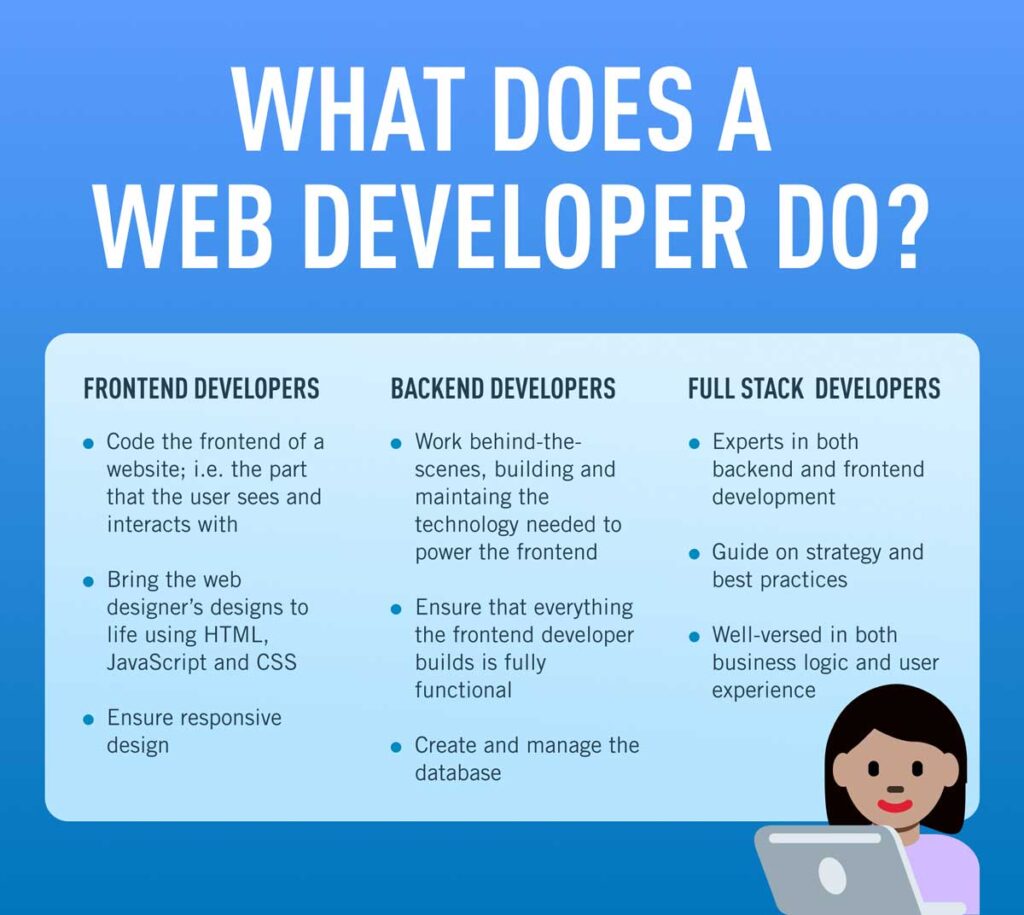In the internet age, where virtual realms intertwine with our daily lives, web development stands as a cornerstone of modern civilization. But what exactly is web development, and what role does it play in shaping the digital landscape we navigate each day? Let’s embark on a journey to unravel the intricacies of this fascinating discipline. What Is Web Development
Defining Web Development
At its essence, web development encompasses the creation and maintenance of websites and web applications. It involves a multidisciplinary approach that combines design, programming, and content creation to bring digital experiences.
Languages and Technologies
Web development relies on a myriad of languages and technologies, each serving a distinct purpose in the construction process. Among the fundamental languages are:
- HTML (Hypertext Markup Language): The backbone of the web, HTML provides the structure and content of web pages, defining elements such as text, images, and links.
- CSS (Cascading Style Sheets): CSS adds aesthetics to HTML, controlling the visual presentation of web pages by defining styles such as colors, fonts, and layouts.
- JavaScript: JavaScript is the language of interactivity, enabling dynamic elements and behaviors on web pages, such as animations, form validation, and asynchronous data loading.
Beyond these core languages, web development encompasses many frameworks, libraries, and tools that streamline the development process and enhance functionality.
The Web Development Process
Web development follows a structured process that begins with conceptualization and ends with deployment. Here’s an overview of the typical stages:
- Planning: In this phase, developers collaborate with stakeholders to define project goals, requirements, and target audience. This stage lays the foundation for the entire development process, guiding decisions on design, functionality, and technology stack.
- Design: Designers create wireframes and mockups that visualize the layout, structure, and user interface of the website or application. This phase focuses on creating intuitive user experiences and visually engaging interfaces.
- Development: Developers bring the design to life through coding, using HTML, CSS, and JavaScript to build the front-end interface and implement functionality. Back-end development involves server-side scripting, database integration, and application logic to support dynamic content and interactions.
- Testing: Quality assurance is crucial to ensuring a seamless user experience. Developers conduct thorough testing to identify and fix bugs, optimize performance, and ensure compatibility across different devices and browsers.
- Deployment: Once the website or application is thoroughly tested and approved, it is deployed to a web server and made accessible to the public. Continuous monitoring and maintenance are essential to keep the digital asset running smoothly and secure against potential threats.
Future of Web Development
It plays a pivotal role in shaping the digital landscape and driving innovation across industries. From e-commerce platforms and social networking sites to online education and remote collaboration tools, the web empowers businesses, organizations, and individuals to connect, communicate, and create value in unprecedented ways.
Looking ahead, the future of web development holds exciting possibilities fueled by emerging technologies such as artificial intelligence, virtual reality, and the Internet of Things. As the digital ecosystem continues to evolve, web developers will remain at the forefront of innovation.
Web Development Services
Here’s a breakdown of some common web development services:
- Custom Website Development: Tailored to specific business needs, custom website development involves creating unique, feature-rich websites from scratch.
- E-commerce Development: E-commerce development focuses on building online stores and platforms for selling products and services. It involves integrating secure payment gateways, managing inventory, implementing shopping carts, and optimizing the user experience for seamless online transactions.
- Content Management Systems (CMS): CMS development involves building websites using popular platforms such as WordPress, Joomla, or Drupal. These systems enable users to easily manage and update content, add new pages, and customize website functionality through plugins and extensions.
- Web Application Development: Web application involves creating interactive and dynamic web-based applications that offer specific functionalities or services.
- Mobile App Development: While distinct from traditional web development, many companies also offer mobile app development services.
- Responsive Web Design: With the proliferation of mobile devices, responsive web design has become essential. Its services often include ensuring that websites are optimized for various screen sizes and devices.
- Website Maintenance and Support: Beyond initial development, it services may also include ongoing maintenance and support. This involves tasks such as updating content and monitoring website performance.
- SEO (Search Engine Optimization): SEO services improve a website’s visibility and rankings in search engine results. This may include keyword research, on-page optimization, link building, and other strategies to drive organic traffic and enhance online visibility.
Types of Web development
Front-End Development: Front-end development focuses on creating the user interface and client-side functionalities of websites and web applications. Front-end developers use languages like HTML, CSS, and JavaScript to design and implement elements that users interact with directly, such as buttons, forms, menus, and animations.
Back-End Development: Back-end involves building the server-side logic and database management systems that power websites and applications. Back-end developers work with languages and frameworks like Node.js, Python, Ruby on Rails, and PHP to handle tasks such as data storage, user authentication, server-side rendering, and API integrations.
Full-Stack Development: Full-stack development combines both front-end and back-end skills, allowing developers to work on all aspects of a project. Full-stack developers are proficient in both client-side and server-side technologies. What Is Web Development


